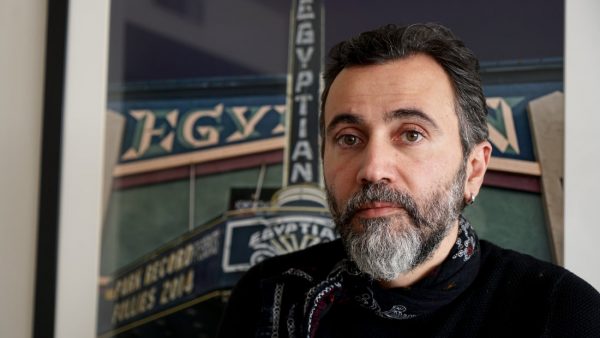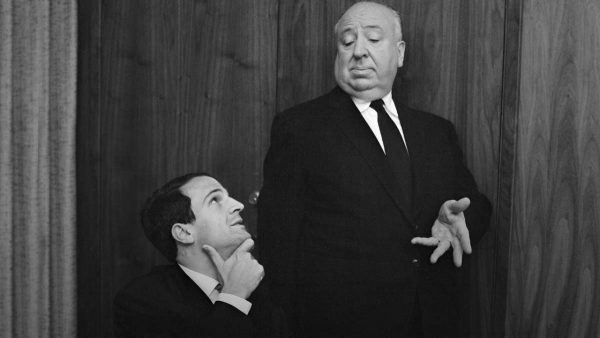Film Feature: STREAMING DOCS — Spring 2019
by Neil Giordano
What are the best new documentaries available on digital platforms? Read on.
The streaming landscape has experienced a couple of tectonic shifts since our last edition of Streaming Docs. With the demise of Film Struck late last year — and the future of Fandor now in doubt — the digital possibilities for viewing substantial documentaries are slimming, especially for those looking for less mainstream, independent, and foreign-language offerings. Still, thankfully, the digital world continues to serve up an embarrassment of riches at the click of a mouse or remote control.
Streaming-only and/or in Limited Theatrical Release

Filmmaker Talal Derki. Photo: Matthew Carey.
Of Fathers and Sons (Kanopy) An unsettling portrait of Islamic militants in northern Syria, from a filmmaker who embedded himself with a family of true believers: Abu Osama, the titular father, and his two oldest sons, Osama and Ayman (named for jihadist heroes). The father pontificates about his dream of destroying Israel and reclaiming Syria for Islamist ideals, to the point he never becomes a two-dimensional figure. Instead, and more terrifyingly, his passion turns him into a caricature: a true believer of a cause he feels is not lost, despite seeing that Syria is in ruins. The sons provide a refreshing counterpoint: 10 year old Osama slowly becomes drawn into the miasma of ideological violence, while the sensitive 12 year old Ayman wishes that he could go to school. In a telling omission, their sisters and mother were forbidden to be seen in the film, aside from a few accidental glimpses when the boys demean their 5 year old sister. There is a childhood for these kids, though it sometimes takes the form of them “playing” a game with a homemade toy landmine. This is intercut with views of their father defusing landmines in the field.
Director Talal Derki caught the world’s attention with his first film, Return to Homs (now streaming on Amazon), a Sundance winner in 2013, which put a human face on the anti-Assad Syrian rebels in the civil war. It also examined the seductions of militancy and radicalism.
Shirkers (Netflix) Any self-avowed film geek will be drawn in by Sandy Tan’s reflection on the beginning of her infatuation with the medium. Shirkers narrates Tan’s youth in Singapore, when she and her best friends began their fledgling efforts at filmmaking with the help of the mysterious teacher/mentor who ended up disappearing with all their footage before they could make a final cut. In this documentary, Tan reconstructs her memories of those years while also resurrecting the ‘lost’ film (which we see in bits and pieces, filled with punk, loony imagery). The documentary also explores the experiences of young women struggling for agency, as they tried to create their own cinephile culture despite restrictions in Singapore (and Asia at large) on what young women are “supposed” to do. Above all, Tan’s film is about being young and in love, in this case enthralled with self-expression, art, and creativity. Arts Fuse‘s Gerald Peary’s full review here.
Hidden Gems

A scene from “Quest.”
Quest (Kanopy) There’s some passing moments of placid summertime activity in Quest — first-time filmmaker Jonathan Olshesvki’s breathtaking documentary — glimpses of North Philadelphia neighborhood life accompanied by some piano-tinged riffs of instrumental hip-hop. The urban African-American experience has rarely looked so promising on screen. A resident tends to a community vegetable garden in full bloom; a bicycle seller cleans the grime off a tire on a girl’s pink bike; an adult basketball tournament moves up and down the court. Here are the elemental rhythms of city life, viewed in bold, vivid, almost over-saturated color.
The scene shifts seamlessly to the film’s protagonist, Christopher “Quest” Rainey, out on his newspaper delivery route, chatting with the neighbors as he walks by. We hear a smidgen of voiceover from him: “In North Philly…when you talk to people, you find out they not as hard as they appear to be.” This, and many moments like it, make Quest a special film. A longitudinal portrait of family and urban culture, we see Rainey’s daughter P.J. grow from child to young woman. Her experiences are tinged with all the joy and sadness you might expect. But there’s also shock when, as a preteen, she loses an eye to random gun violence down the street from their apartment. The family thrives and struggles; we catch some of the suggestions of African-American hope in the latter Obama years, with hints of the coming Trump era and what that might mean to Americans like the Raineys.
Zaatari Djinn (Amazon) Amid so many films about the Syrian civil war, Zaatari Djinn offers a unique window into the tragedy. It documents Syrian childhood in a Jordanian refugee camp (Zaatari) where 80% of the population are kids. Five children are looked at close-up, each with something to tell us about their simple yet circumscribed lives. The rebellious Fatma cadges her mother’s lipstick and likes knocking over furniture. Hammoudi sells his bicycle so that he can help support his broken family. Maryam, a slight girl, wants to join the acting troupe and practice soccer, but drops out of both because her father forbids her. The “djinn” of the title refers to the spirits haunt the camp population: they bring good and bad luck to the residents. But the children are determined to control their own fate, to imagine a future as they wait and wonder what will become of their homes and their homeland.
Recent Award Winners and Nominees
Cartel Land (Netflix, Amazon, Kanopy) A troubling look at the ubiquity of the Mexican drug cartels in daily life on both sides of the border. The film follows the experiences of a local vigilante border militia in Arizona and their southern Autodefensa counterparts. The Americans come across as grown men pretty much playing at war but, for the Mexicans it is a battle for self-preservation, an attempt to mitigate the carnage cartels inflict on civilians. Compelling interviews, as well as what we see, suggest a blurring of the lines: a fusion of criminality, self-defense, and government impotence and collusion. Director Matthew Heineman went on to make the acclaimed City of Ghosts (on Amazon) and the narrative feature A Private War (2018).
Documentary Shorts

A scene from “Period. End of Sentence.”
Period. End of Sentence. (Netflix) The 2019 Oscar-winning short documents the efforts of a group of American girl activists to make “menstrual equality” global by providing cheap tampons to women and girls in rural India. The young women are also dedicated to generating international awareness, fighting the social stigmas associated with menstruation in non-western cultures where girls cannot attend school or even leave their homes while having their periods.
Heaven Is Traffic Jam on the 405 (Kanopy) A joyful if wary portrait of Los Angeles artist Mindy Alper, who has suffered from severe anxiety since childhood. She pours her emotional life into her autobiographical drawings and sculptures. Winner of the 2018 Oscar for Documentary Live-Action Short.
Last Day of Freedom (Kanopy) A captivating film about family and mental health, told through stark but beautiful hand-drawn animations. Bill Babbitt narrates the story of his formerly homeless brother, Manny — a Vietnam vet suffering from schizophrenia and PTSD — whom he invites to live with his family in California. Bill soon realizes that Manny has killed someone. He must decide what is best for Manny: to turn him in, or to cover for him? A 2018 Oscar nominee for Animated Short.
Documentary Classics
Sherman’s March (Fandor) Nominally, Ross McElwee’s highly personal 1986 film has him retracing the Union’s slash-and-burn march through Georgia to the Atlantic during the Civil War. But it is more concerned with McElwee’s own personal journey, as he contemplates love, family, solitude, and annihilation amid the height of the Reagan-era Cold War.
Quick Takes
Step (Hulu) This is the rousing story of a girls’ step-dance team from Baltimore in pursuit of a national championship. The school’s admirable goal is for all of them to earn a place in college.

A scene from “Hitchcock Truffaut.”
Hitchcock Truffaut (Kanopy) One of the greatest long-form interviews in filmmaking history took place between François Truffaut and Alfred Hitchcock, published in a celebrated 1962 book. That dialogue is revisited and interpreted with archival footage, stills, and reflections from contemporary directors, including Wes Anderson, David Fincher, and Olivier Assayas. A joy for cinephiles.
Elstree 1976 (Kanopy, Netflix) A fun yet sometimes eye-rolling behind-the-scenes look at the bit players from the original Star Wars: it is about the unsung actors who struggled to milk their fame from appearing in the biggest blockbuster ever. Arts Fuse review
Waiting for Lightning (Kanopy, Amazon) The story of world-renowned skateboarder Danny May and his quest to jump over the Great Wall of China. It may sound like a dubious achievement, but this film is absorbing as it details the wide-ranging preparations involved (logistic and political) though, strangely, it doesn’t offer much screen time with May himself, who has little to say but much to prove.
Neil Giordano teaches film and creative writing in Newton. His work as an editor, writer, and photographer has appeared in Harper’s, Newsday, Literal Mind, and other publications. Giordano previously was on the original editorial staff of DoubleTake magazine and taught at the Center for Documentary Studies at Duke University.
